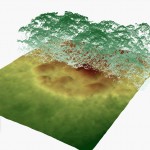Seekers of past Honduran, Mexican civilizations to speak Wednesday at Meeting of Americas
14 May 2013
Cancún Center
Cancún, Mexico
13-17 May 2013
Cancún, Mexico—A high-tech archeological exploration team of scientists and a filmmaker, who announced a year ago that they had glimpsed remnants of what might be a fabled ancient city in the Honduran rain forests, plans to speak about the team’s discoveries here tomorrow (15 May) at the 2013 Meeting of the Americas, and to show previously undisclosed images of apparent archeological sites.

The Honduran Mosquitia’s dense canopy of tree tops rising some 50 meters (164 feet) above the forest floor has long concealed structures on the ground. Scientists can now detect those structures from aircraft using light-detection-and-ranging (lidar) — a laser-based technology. (Credit: UTL Productions, LLC)
A 7-page article in last week’s The New Yorker magazine by Douglas Preston set the stage for tomorrow’s discussion of the Honduras venture and other similar explorations. The article tells the story of University of Houston, Texas, scientists who are specialists in the imaging technique known as light-detection-and-ranging (lidar) and were brought to the forbidding Mosquitia region of Honduras by documentary filmmaker Steven Elkins and expedition underwriter and filmmaker Bill Benenson. Elkins is the leader of the Honduras exploration and runs it as a project of UTL Productions LLC and UTL Scientific LLC.
The scientists — William Carter, Juan Fernandez-Diaz and Ramesh Shrestha — organized tomorrow’s 8-10 a.m. session at the Meeting of the Americas, entitled “G31A. Geodetic Imaging Using Light Detection and Ranging (Lidar),” at which applications of lidar in archeology and other fields, such as seismology and oceanography, will be discussed.
The New Yorker article describes how these researchers used their laser-based equipment aboard a slow, low-altitude aircraft flying over swaths of dense jungle to bombard the terrain below with billions of laser pulses and thereby peer through the thick forest canopy. Their data, Preston writes, reveal what might be extensive, ancient ruins beneath that canopy – cities, villages, roads, canals, ceremonial sites, terraced agricultural land, and more — potentially the remains of a previously unknown civilization. Preston also recounts the reactions of archeologists who have marveled at the new, tentative evidence and the technique by which it was gathered, declaring that the method is revolutionizing their field.

Partially removing the lidar measurements corresponding to the tree canopy above a site in the Honduran rain forest reveals structures on the ground that make up a portion of a much larger complex. (Credit: UTL Scientific, LLC)
Another scientific author listed on tomorrow morning’s Geodetic Imaging session is archeologist Christopher Fisher of Colorado State University, in Fort Collins, who has also taken part in the Honduras project and is one of the few archeologists to have extensively studied lidar images from the Honduras flights.
Fisher and his Colorado State colleague Stephen Leisz also use lidar to find previously unrecognized ancient human-made structures at Angamuco, a site in Mexico. “We use lidar to pinpoint where human structures are by looking for linear shapes and rectangles,” Leisz said. “Nature doesn’t work in straight lines.”
The Houston researchers, Fisher, and Leisz have previously written about their lidar work in an article in Eos, the newspaper of the Earth and space sciences, which is published by the American Geophysical Union.

A complex of mounds and, possibly, ancient building foundations becomes visible (bottom image) when laser reflections from the tree canopy (green in top image) are filtered out of the lidar data from a site in the Mosquitia region of Honduras. (Credit: UTL Scientific, LLC)
Elkins, who will also attend the session, said he and his colleagues will unveil images from the Honduras sites that have not previously been made public, including those attached to this release. “But we can’t show the overall place because we’d like to protect the site” from treasure hunters and looters, he said. A crucial next step, he added, will come later this year when archeologists plan to explore the features seen from the air on the ground, to find out what’s really there.
The Geodetic Imaging session G31a will take place from 8a.m. to 10 a.m. local Cancún time (Central Daylight Time, UTC/GMT – 5 hours) in Salon Cozumel 3 (Cancun Center).
Joint Release
AGU Contact:
Peter Weiss, +1 202 777 7507, [email protected]
Under the LIDAR (UTL) Contact:
Maggie Begley, +1 310 301 1785, +1 310 749 3055 Cell
[email protected]